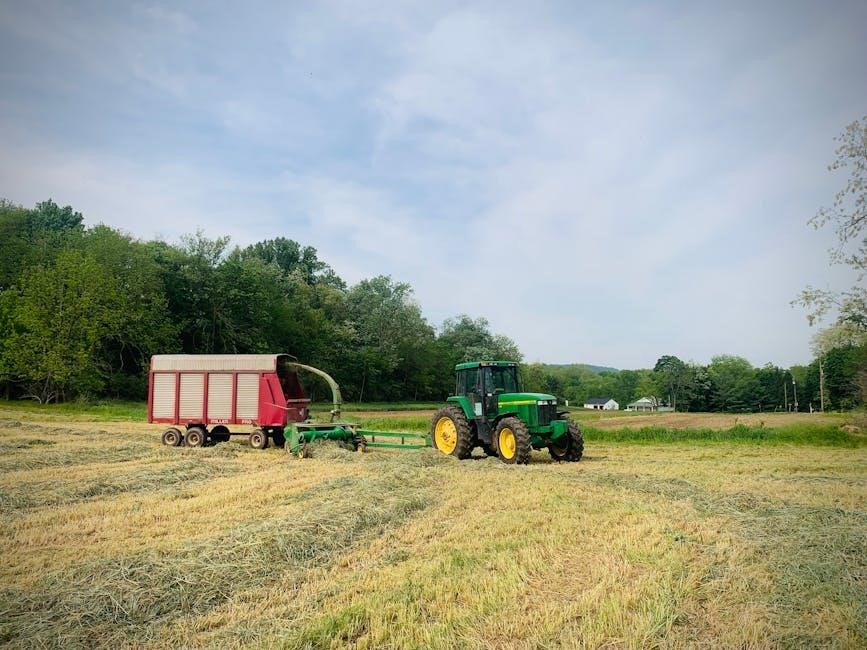
john deere fault codes pdf
John Deere fault codes are essential diagnostic tools used to identify and troubleshoot issues in John Deere machinery, ensuring efficient repair and maintenance processes.
What Are John Deere Fault Codes?
John Deere fault codes are alphanumeric codes generated by the machine’s Electronic Control Unit (ECU) to indicate specific issues or malfunctions. These codes serve as a communication tool between the machine and the operator or technician, providing insights into system errors. Each code corresponds to a particular problem, such as sensor failures, hydraulic issues, or engine malfunctions. By understanding these codes, users can identify the root cause of a problem and take corrective action. They are essential for efficient troubleshooting and ensuring optimal machine performance, making them a vital resource for maintenance and repair.
The Importance of Understanding Fault Codes
Understanding John Deere fault codes is crucial for maintaining machinery efficiency and preventing costly repairs. These codes provide immediate insights into system malfunctions, allowing operators to address issues promptly. Ignoring or misinterpreting codes can lead to further damage, increased downtime, and higher repair costs. By deciphering fault codes, technicians can diagnose problems accurately, reducing guesswork and ensuring effective solutions. This knowledge is essential for optimizing machine performance, extending equipment lifespan, and enhancing overall productivity. Regular training and reference to diagnostic manuals or PDF guides help users master fault code interpretation, making it a vital skill for anyone working with John Deere equipment.
How Fault Codes Help in Troubleshooting
John Deere fault codes are invaluable for streamlined troubleshooting, providing clear guidance to identify and resolve machinery issues efficiently. These codes pinpoint specific malfunctions, such as engine, hydraulic, or transmission problems, eliminating guesswork. By referencing diagnostic manuals or PDF guides, technicians can quickly interpret codes, diagnose root causes, and implement targeted repairs. This process reduces downtime, minimizes unnecessary part replacements, and ensures accurate fixes. For example, a code like 916.14 may indicate hydraulic filter issues or electronic glitches, directing technicians to specific solutions. Fault codes thus serve as a critical roadmap for effective problem-solving and maintenance.

How John Deere Diagnostic Systems Work
John Deere diagnostic systems rely on the Electronic Control Unit (ECU), which monitors machine performance through sensor inputs and communicates with components to detect and report faults.
Overview of the Electronic Control Unit (ECU)
The Electronic Control Unit (ECU) is the core of John Deere’s diagnostic system, monitoring and controlling machine operations. It processes data from various sensors, such as throttle position, fuel flow, and temperature, to ensure optimal performance. The ECU stores fault codes when it detects anomalies, which are then displayed on the machine’s dashboard or retrieved using diagnostic tools. These codes help technicians identify specific issues, ranging from sensor malfunctions to software glitches. Regular updates to the ECU’s firmware ensure compatibility with evolving technology and improve diagnostic accuracy, making it a crucial component for efficient troubleshooting and maintenance.
Sensor Inputs and Their Role in Diagnostics
Sensors play a vital role in John Deere diagnostics by monitoring critical machine components, such as engines, hydraulics, and transmissions. These sensors continuously send data to the ECU, ensuring accurate machine performance. Temperature, pressure, and flow sensors are common examples, providing real-time feedback. If a sensor detects an abnormal reading, it triggers a fault code, alerting the operator to potential issues. This data is essential for diagnosing problems quickly and efficiently, reducing downtime and ensuring proper repairs. Sensor accuracy is crucial for reliable fault code generation and effective troubleshooting. Regular sensor calibration and maintenance are recommended to optimize diagnostic performance.
Communication Between ECU and Machine Components
The Electronic Control Unit (ECU) acts as the central controller, communicating with various machine components through advanced protocols like CAN bus or proprietary John Deere networks. This communication enables real-time data exchange, allowing the ECU to monitor and control functions such as engine speed, hydraulic flow, and transmission operation. When a component malfunctions, the ECU detects irregularities and generates specific fault codes. This seamless interaction ensures precise diagnostics and efficient troubleshooting. The ECU also coordinates responses across systems, optimizing performance and reliability. Proper communication is critical for accurate fault detection and maintaining machine efficiency. Regular system checks ensure uninterrupted data flow and reliable operation.
Types of John Deere Fault Codes
John Deere fault codes are categorized into critical, non-critical, and manufacturer-specific codes, each indicating different levels of severity and system-specific issues for precise diagnostics.
Critical Fault Codes
Critical fault codes indicate severe issues requiring immediate attention to prevent damage or safety hazards. These codes often relate to essential systems like engine, transmission, or hydraulic functions. Ignoring critical codes can lead to costly repairs or operational downtime. They are typically marked with high priority in diagnostic systems, ensuring operators address them promptly. For example, a critical code might signal a malfunction in the engine’s cooling system or a failure in the hydraulic pump. Understanding these codes is crucial for maintaining machine performance and safety, as they often signify potential risks if left unresolved. Always refer to the John Deere fault codes PDF for accurate interpretations.
Non-Critical Fault Codes
Non-critical fault codes indicate issues that do not immediately affect machine operation or safety but may lead to problems if ignored. These codes often relate to secondary systems, such as warning lights, sensor malfunctions, or minor component failures. Addressing non-critical codes during routine maintenance can prevent them from escalating into critical issues. For example, a code might signal a faulty dashboard indicator or low battery voltage. While these issues are less urgent, resolving them ensures optimal performance and longevity of the equipment. Always consult the John Deere fault codes PDF for detailed explanations and recommended actions for non-critical codes. Regular checks can help maintain efficiency.
Manufacturer-Specific Codes
Manufacturer-specific codes are unique to John Deere equipment and are not part of standard fault code systems. These codes are designed to address issues specific to John Deere’s proprietary systems, components, or software. They often relate to advanced features, such as autonomous operations or precision agriculture. For example, codes may indicate issues with specialized sensors, GPS systems, or integrated control modules. These codes require consultation of John Deere’s official documentation or diagnostic tools for accurate interpretation. Manufacturer-specific codes highlight the importance of using authorized John Deere resources for troubleshooting. Always refer to the John Deere fault codes PDF for precise decoding and solutions;

Retrieving Fault Codes
Retrieving John Deere fault codes involves using diagnostic tools or manual methods to access error information stored in the machine’s electronic control system. Operators can utilize John Deere-approved scanners or refer to the John Deere fault codes PDF guide for step-by-step instructions. This process ensures accurate identification of issues for efficient troubleshooting and repair. Always follow manufacturer guidelines to avoid data misinterpretation.
Using Diagnostic Scanners
Diagnostic scanners are essential tools for retrieving John Deere fault codes efficiently. These scanners communicate with the machine’s ECU to display active or stored fault codes, aiding in quick diagnostics. Modern scanners offer features like real-time monitoring, code clearing, and detailed explanations. Operators can use John Deere-approved scanners or third-party tools compatible with their equipment. Referencing the John Deere fault codes PDF guide ensures accurate interpretation of the codes displayed by the scanner. Proper use of diagnostic scanners streamlines troubleshooting and minimizes downtime, helping technicians address issues promptly and effectively. Always follow the manufacturer’s instructions for optimal results.
Manual Retrieval Methods
Manual retrieval of John Deere fault codes can be performed without specialized tools, using the machine’s control panel or dashboard. Operators can navigate to the diagnostics menu, where fault codes are displayed. This method is useful for basic troubleshooting and identifying issues quickly. However, it may not retrieve stored or complex codes. Referencing the John Deere fault codes PDF guide is essential to interpret the codes accurately. While manual retrieval is helpful, it has limitations compared to diagnostic scanners, which provide more detailed information and streamline the process. Always ensure the machine is in a safe state before attempting manual retrieval.
Understanding the Code Display System
John Deere fault codes are displayed through a structured system, typically using alphanumeric codes. Each code corresponds to a specific issue, making it easier to identify and address problems. The codes are usually displayed on the machine’s control panel or diagnostic interface. The John Deere fault codes PDF provides detailed explanations of these codes, helping users understand their meanings and severity. This system ensures consistency and clarity, allowing operators to quickly diagnose issues. Understanding the display system is crucial for effective troubleshooting and maintaining machine performance. Always refer to the official PDF guide for accurate interpretations and solutions.

Interpreting Fault Codes
Interpreting John Deere fault codes involves understanding their structure and using the provided PDF guide. Each code, such as “E123” or “F456,” corresponds to specific issues. The guide offers detailed explanations, helping users identify problems and necessary repairs. It categorizes codes by severity, distinguishing critical issues from less urgent ones. Additionally, the PDF includes troubleshooting steps and examples of common codes, aiding in effective diagnosis and resolution.
Structure of John Deere Fault Codes
John Deere fault codes are alphanumeric sequences designed to identify specific issues within machinery. Typically, codes consist of a combination of letters and numbers, such as “E123” or “F456.” The structure is standardized, with the first character often indicating the system affected (e.g., “E” for engine, “F” for fuel). Subsequent numbers or letters provide deeper details about the issue, such as sensor malfunctions or error types. The provided PDF guide explains this structure, enabling users to decode each part of the code and pinpoint the root cause. This systematic approach ensures clarity and efficiency in diagnosing and resolving problems.
Common Examples of Fault Codes
The John Deere fault codes PDF provides examples of frequently encountered codes, such as “E235” for engine speed sensor malfunctions or “F120” for fuel pressure sensor issues. Codes like “H345” may indicate hydraulic system overheating, while “T678” could signal transmission slip detection. Each code corresponds to a specific system or component, helping users quickly identify potential problems. The PDF guide includes a comprehensive list of codes, along with brief descriptions, to aid in understanding and addressing common machinery issues effectively. This resource is invaluable for operators and technicians seeking to diagnose and repair equipment efficiently.
Decoding Fault Code Meanings

Decoding John Deere fault codes involves understanding their unique structure, typically a combination of letters and numbers. For example, “E” may represent engine-related issues, while “H” could indicate hydraulic system problems. The numerical part of the code narrows down the specific fault, such as sensor malfunctions or system errors. The John Deere fault codes PDF provides detailed explanations, enabling users to interpret each code accurately. This decoding process is essential for identifying the root cause of machinery issues, ensuring timely and effective repairs. Proper understanding of these codes enhances diagnostic efficiency and reduces downtime significantly.

Troubleshooting and Repair
Troubleshooting and repair involve identifying fault codes, isolating issues, and implementing corrective actions. Testing repairs ensures machinery functionality. Always follow John Deere guidelines for optimal results.
General Troubleshooting Procedures
General troubleshooting begins with retrieving fault codes using diagnostic tools like Service Advisor. Inspect wiring and connections for damage or corrosion. Check sensors for accuracy and ensure proper calibration. Verify fluid levels and filter conditions. Test components based on fault code descriptions. Isolate issues by recreating operating conditions when the fault occurred. Consult repair manuals or online resources for specific guidance. Clear codes after repairs and test machinery to confirm resolution. Document findings for future reference and preventive maintenance. Always follow safety protocols when working with electrical or hydraulic systems.
Specific Fault Code Solutions
Addressing specific fault codes requires targeted actions based on the code’s meaning. Start by identifying the code and referencing the John Deere service manual or diagnostic software for detailed instructions. For example, a fault code indicating a faulty sensor may involve cleaning, recalibrating, or replacing the sensor. If the issue persists, check related components like wiring or connectors. Some codes may require resetting parameters or updating software. Always follow manufacturer guidelines and safety precautions. If unsure, consult a certified technician to avoid further damage. Proper documentation of repairs helps track recurring issues and ensures long-term machine reliability.
When to Contact a Dealer or Technician
If a fault code indicates a critical issue or you’re unsure about the solution, it’s essential to contact a John Deere dealer or certified technician. Critical codes often relate to safety or major system failures, requiring specialized tools and expertise. Additionally, if DIY troubleshooting doesn’t resolve the issue or if the problem recurs after repairs, professional assistance is recommended. Dealers have access to advanced diagnostic software and genuine parts, ensuring accurate fixes. They can also address complex electrical or hydraulic system problems. Don’t hesitate to seek help to prevent further damage and ensure compliance with warranty terms.

Maintenance and Prevention
Regular servicing, filter replacements, and fluid checks help prevent fault codes. Updating software ensures optimal performance, and inspecting components for wear reduces the risk of system failures.
Regular Maintenance to Prevent Faults
Regular maintenance is crucial for preventing fault codes in John Deere equipment. Routine servicing, such as oil changes and filter replacements, ensures optimal performance. Checking fluid levels, including hydraulic and coolant, helps prevent system failures. Inspecting electrical connections for corrosion or damage can avoid communication errors. Additionally, updating the machine’s software and firmware guarantees compatibility and functionality. Performing these preventive measures reduces the likelihood of critical faults, minimizing downtime and repair costs. Consistent maintenance also extends equipment lifespan and enhances overall productivity, making it a cornerstone of effective machinery management.
Updating Software and Firmware
Updating software and firmware is essential for maintaining optimal performance and preventing fault codes. John Deere regularly releases updates to fix bugs, improve functionality, and enhance compatibility with diagnostic tools. Operators should use authorized John Deere software tools or consult the operator’s manual for guidance. Ensuring the latest versions are installed helps prevent system glitches and ensures accurate fault code detection. Regular updates also improve communication between components, reducing the likelihood of errors. Staying current with software updates is a proactive step in avoiding operational disruptions and extending equipment longevity.
Monitoring Machine Performance
Monitoring machine performance is crucial for early detection of potential issues before they escalate. John Deere equipment is equipped with advanced sensors and telemetry systems that provide real-time data on operational status. Operators can track parameters such as engine performance, hydraulic pressure, and temperature levels. Regular monitoring helps identify trends and anomalies, enabling proactive maintenance. By leveraging diagnostic tools and the Vehicle Health Monitor, users can address minor issues before they lead to critical faults. Consistent oversight ensures optimal efficiency, reduces downtime, and extends the lifespan of machinery, making it a key practice for effective equipment management.

Common Fault Codes and Their Meanings
John Deere fault codes identify specific issues, such as hydraulic malfunctions (CODE 61) or engine temperature warnings (CODE 81). Each code provides clear guidance for troubleshooting and repair.
Hydraulic System Faults
Hydraulic system faults in John Deere equipment are often indicated by specific codes, such as CODE 63 for low hydraulic pressure or CODE 65 for high temperature. These codes help identify issues like faulty pressure sensors, blocked oil filters, or malfunctioning pumps. Regular maintenance, such as checking fluid levels and replacing filters, can prevent these faults. Ignoring these codes may lead to system damage. Always refer to the John Deere fault codes PDF for detailed troubleshooting steps and repair guidance to ensure optimal hydraulic system performance and prevent costly downtime.
Engine and Fuel System Issues
Engine and fuel system issues are common in John Deere machinery, often signaled by fault codes like CODE 105 (low fuel pressure) or CODE 110 (high engine temperature). These codes indicate problems such as faulty fuel injectors, clogged fuel filters, or malfunctioning coolant sensors. Regular maintenance, like cleaning or replacing fuel filters and checking coolant levels, can help prevent these issues. Ignoring these codes may lead to engine damage or downtime. Always consult the John Deere fault codes PDF for detailed troubleshooting and repair steps to ensure proper engine and fuel system operation and longevity.
Transmission and Drivetrain Problems
Transmission and drivetrain issues in John Deere machinery often trigger specific fault codes, such as CODE 1401 (transmission solenoid malfunction) or CODE 1402 (low transmission pressure). These codes highlight problems like faulty solenoids, worn clutch packs, or low fluid levels. Regular checks of transmission fluid and filter condition can prevent these issues. Ignoring these codes may lead to reduced machine performance or costly repairs. Referencing the John Deere fault codes PDF provides detailed steps to diagnose and address transmission and drivetrain faults effectively, ensuring smooth operation and minimizing downtime.

Diagnostic Tools and Resources
The John Deere fault codes PDF provides access to advanced diagnostic tools, including the Service Advisor software, for real-time monitoring and error code analysis. These resources enable precise troubleshooting, ensuring efficient repairs and minimizing downtime by identifying issues quickly. Regular updates to the tools and guides help users stay informed about the latest fault codes and solutions, promoting optimal machine performance and reliability.
John Deere Diagnostic Software
John Deere diagnostic software, such as Service Advisor, provides comprehensive tools for identifying and resolving fault codes. It offers real-time data monitoring, diagnostic tests, and detailed repair guidance. Technicians can access fault code explanations, troubleshooting steps, and repair procedures. The software is compatible with various John Deere equipment, ensuring precise diagnostics. Regular updates keep the system current with new fault codes and solutions. This software is essential for efficient troubleshooting, minimizing downtime, and maintaining machine performance. It is a vital resource for both professionals and operators relying on John Deere machinery.
Third-Party Diagnostic Tools
Third-party diagnostic tools offer alternative solutions for reading and interpreting John Deere fault codes. These tools, like generic OBD-II scanners or specialized agricultural diagnostics software, provide varying levels of compatibility with John Deere systems. They often cater to smaller operations or independent technicians, offering cost-effective alternatives to official software. While they may lack the full functionality of John Deere’s Service Advisor, they can still display fault codes and basic diagnostic information. However, compatibility and accuracy may vary, making them less reliable for complex issues. These tools are best for limited diagnostics or when official software is unavailable.
Online Resources for Fault Code Lookup
Online resources provide convenient access to John Deere fault code information, enabling quick lookups and interpretations. The official John Deere website offers detailed fault code databases and service manuals. Additionally, forums and communities dedicated to agricultural equipment often share fault code lists and troubleshooting guides. Websites like RepairManuals.com or ManualsLib host PDF manuals and fault code charts for various John Deere models. These resources are invaluable for operators and technicians seeking to identify and resolve issues efficiently. Always verify the credibility of the source to ensure accurate and reliable information.

Case Studies and Real-World Examples
Real-world examples demonstrate how John Deere fault codes resolved issues like hydraulic malfunctions and engine errors. PDF guides detail these cases, offering practical insights for operators.
Common Issues in John Deere Machinery
Common issues in John Deere machinery often relate to hydraulic system malfunctions, engine performance problems, and transmission errors. Fault codes such as P0685 (ECU power supply error) and P0299 (low engine oil pressure) frequently occur. These issues can stem from worn components, sensor failures, or software glitches. Hydraulic system faults, like F2080 (priority valve malfunction), are also prevalent. Operators often report errors during heavy-duty operations or extreme weather conditions. Regular maintenance, such as updating software and replacing faulty sensors, can prevent these issues. John Deere fault codes PDF guides provide detailed insights into diagnosing and resolving these problems effectively.
How Fault Codes Helped Resolve Specific Problems
Fault codes have been instrumental in diagnosing and resolving specific issues in John Deere machinery. For instance, a technician encountered a recurring P0299 code indicating low engine oil pressure in a John Deere tractor. By referencing the fault code in a John Deere fault codes PDF, the technician identified faulty oil pressure sensors as the root cause. Replacing the sensors resolved the issue, preventing potential engine damage. Similarly, a F2080 code led to the discovery of a malfunctioning priority valve in the hydraulic system, which was promptly repaired. These examples highlight how fault codes provide clear guidance for effective troubleshooting and maintenance, ensuring machinery operates optimally and minimizing downtime.
Lessons Learned from Troubleshooting
Troubleshooting John Deere machinery using fault codes has revealed valuable insights. Early identification of issues through codes often prevents minor problems from escalating into major repairs. Regular maintenance, such as cleaning sensors and updating software, can significantly reduce fault occurrences. Additionally, understanding the diagnostic process encourages operators to address issues promptly rather than ignoring warning signs. The integration of diagnostic tools with fault codes has also highlighted the importance of staying updated with the latest John Deere resources and guidelines. These experiences underscore the value of proactive maintenance and the role of fault codes in enhancing machine reliability and performance.
Understanding John Deere fault codes is essential for efficient diagnostics and maintenance, ensuring optimal machinery performance and minimizing downtime through timely issue resolution and preventive care.
John Deere fault codes are critical for diagnosing machinery issues, enabling timely repairs and minimizing downtime. These codes, detailed in PDF guides, categorize faults as critical or non-critical, with specific codes for engine, hydraulic, and transmission problems. Retrieval methods include diagnostic scanners and manual checks, while interpretation requires understanding code structures and meanings. Regular maintenance, software updates, and performance monitoring prevent faults. Troubleshooting involves general procedures and code-specific solutions, with complex issues requiring professional assistance. Utilizing diagnostic tools and resources ensures accurate fault identification and resolution, enhancing overall machine efficiency and longevity.
The Future of John Deere Diagnostic Systems
The future of John Deere diagnostic systems lies in advanced technology integration, such as AI-driven predictive maintenance and real-time telematics. These systems will likely incorporate machine learning to anticipate faults before they occur, reducing downtime. Enhanced IoT connectivity will enable seamless communication between machines and operators, while augmented reality tools may assist technicians in complex repairs. Over-the-air software updates will ensure systems remain up-to-date, improving functionality and security. These innovations aim to increase efficiency, accuracy, and user experience, solidifying John Deere’s leadership in agricultural and heavy machinery diagnostics.
Final Thoughts on the Importance of Fault Codes
John Deere fault codes are essential for efficient machinery maintenance and operation. They provide clear, actionable insights into system issues, enabling quick identification and resolution of problems. By understanding these codes, operators and technicians can minimize downtime, reduce repair costs, and optimize performance. Regular monitoring and interpretation of fault codes foster proactive maintenance, preventing minor issues from escalating. This empowers users to manage their equipment effectively, ensuring reliability and productivity. In conclusion, fault codes are a vital tool for maintaining John Deere machinery, offering significant benefits for both routine upkeep and long-term operational success.

Leave a Reply
You must be logged in to post a comment.